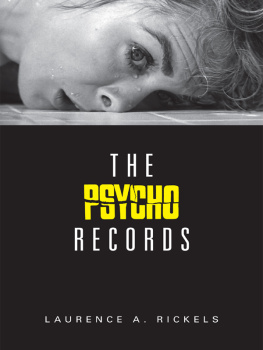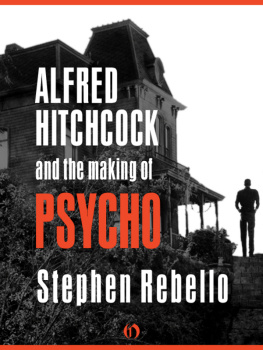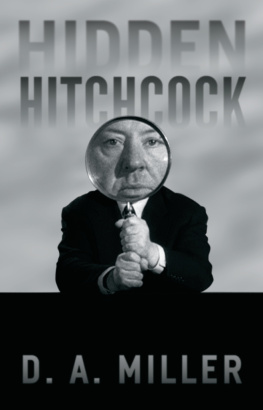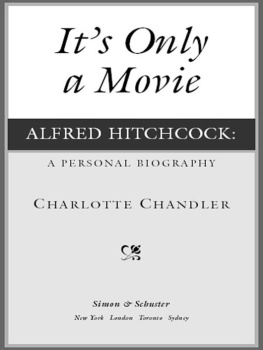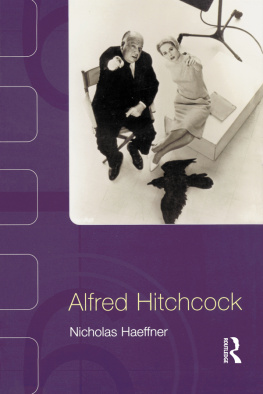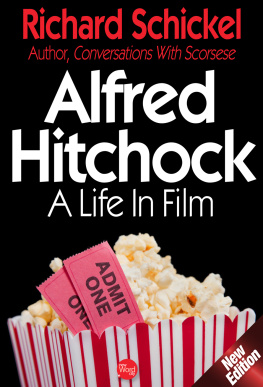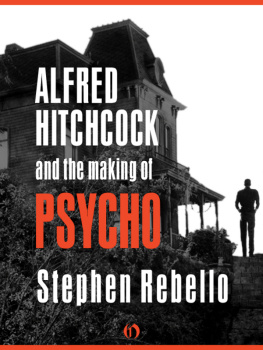Table of Contents
THE PSYCHO RECORDS
THE PSYCHO RECORDS
LAURENCE A. RICKELS
A Wallflower Press Book
Published by
Columbia University Press
Publishers Since 1893
New York Chichester, West Sussex
cup.columbia.edu
Copyright 2016 Columbia University Press
All rights reserved.
E-ISBN 978-0-231-54349-1
Wallflower Press is a registered trademark of Columbia University Press
A complete CIP record is available from the Library of Congress
ISBN 978-0-231-18112-9 (cloth : alk. paper)
ISBN 978-0-231-18113-6 (pbk. : alk. paper)
ISBN 978-0-231-54349-1 (e-book)
A Columbia University Press E-book.
CUP would be pleased to hear about your reading experience with this e-book at .
Cover image: Psycho (1960) Paramount
Contents
Nazi Germany and Ed Gein; death is always murder; mass cultures of preparedness; The Bad Seed and Winnicotts allegory of hope
If at first only zombie movies succeed, then eight years later bring back vampirism, the return of hope; integration of the vampire (Blade, Underworld); Twilight and the pre-teen, post-Buffy media market; true bloodlines pitch Dracula against Jack the Ripper; by mournings light we can begin to face our double, the psycho
Adorno on television; the withdrawal of sublimation and of the transitional object; the shower scene as altar of mass media culture; the public shower in Carrie; cutting closer to the screen than Les Diaboliques; disrespecting mother; perfect TV in the sound mix; Hitchcock is dead (undead, undead): let the sequels begin
Eyes Without a Face and the serial heterograft; Peeping Tom and the cinematic horror apparatus of sight unseen; cryptology and The Gold Bug; Raising Cain; Frenzy of diagnosis; the psychotic and the psychopath are in it together (In Cold Blood)
Fido and zombie fathers as totem pets; virulence of the taboos upon the dead; I Am Legend and a vampiric mourner in a world of zombie consumerism; disrespecting the buried dad; the fruit cellar in Night of the Living Dead and Fade to Black; getting past Bens murder by the protocols of terrorism (Dawn of the Dead, Day of the Dead); Romero mixes his favorite Martin out of equal parts psycho and vampire; Roland Kuhn on psychopathic fetishism with human material
Hand-to-eye coordination in horror films (The Crawling Hand, Dr. Jekyll and Mr. Hyde, The Hand); Ernst Kapp and the hand-held progress of technology; Hershell Gordon Lewis and the Grand Guignol of special effects (Blood Feast, Two Thousand Maniacs!, Color Me Blood Red); whose hands fulfill my death wishes? (Mad Love); dial M (by Fritz Lang) for serial murder
Arrest in Pieces; grave top publishing in The Texas Chainsaw Massacre; haunted Holmes and hotels (Motel Hell, Hell House); Texas is only a few hours from the Coast or New York City (The Hills Have Eyes, The Last House on the Left)
Sance on a Wet Afternoon and Family Plot; the double as mask in William Wilson; the tomb show of unmasking in Phantom of the Opera; Spiritualism, investigative reporting, and detective fiction; envy in Phantom of the Paradise
Maniac and the POV-mask of the dead; killer mascots in Halloween and Friday the 13th; Kuhn and Elias Canetti on both sides of the mask; the unmasking of Michael Myers and the transvaluation of Lauries survival
Incest is best for werecats; Val Lewton and the horror of leaving it blank; Canetti on keeping in touch in groups; the American flirt meets the haunted commitment from Europe (Cat People); the Fatal Attraction of group or groupie
Schizoid, Dont Answer the Phone, and transference transgression; do you like Hitchcock, Powell, and Romero? (Sisters); the new Norman in Dressed to Kill, Blow Out, and Body Double; the feminist reproach in Slumber Party Massacre
War trauma besets the next generation (The Prowler); on the rebound from the containment of the Psycho Effect (A Nightmare on Elm Street); were in the inoculation now (Freddy vs. Jason); Freddy Kruegers cyberglove as advance preview of new media falls short; misplaced prospects in Shocker and Wes Cravens New Nightmare; reckoning with Freud in the 1980s and 90s
Just Before Dawn; the mirror mother between Lacan and Winnicott; the internal home movie made by psychos, the slasher movie on TV decoded by gadget-loving expertise, and the greater film of Sids survival (Scream, Scream 2, Scream 3); treating the mothers depression in the child (Mothers Day and Baby)
Spoiler alert: occupational therapy for academics; The Sixth Sense and the ghost of the Psycho Effect; The Blair Witch Project and the house of leave-taking; therapeutic closure under demonic attack (The Ring); turning up the contrast on testimony between Prom Night and I Know What You Did Last Summer; who, what, how but why? (CSI); the purloined letter or underlying label (Manhunter); infernal projective identification; the old Saw of torture-teaching; psychopathys true self is the prize for passing the test of survival
.
William Murphy was responsible for the deal that sealed my first (double) profile as author: in exchange for letting him publish as a book the transcript of my vampire lectures, he brokered a contract for my three-volume work Nazi Psychoanalysis. But then he left university press publishing and entered the mainstream. Since that highlight I have relied on the kindness of stranger editors. One stint of mutual estrangement went on for so long you might wonder why I kept trying to make it work. For the children. My thanks to Yoram Allon, Commissioning Editor at Wallflower Press, for including this book in a list pitched equally to US and UK readerships, a targeting opportunity I appreciate given my current expat situation.
Y ou get a break today because were back in class. At least the first layer of this book dates back to the tape recording of lectures comprising my course on The Horror Film. They reach back to the same era from which I sprung The Vampire Lectures. In the longer while between that transcription period and the completion of these New Vampire Lectures, I was able, by catching up with the laying and layering on of changes, at once to update and conclude my California chronicles of occult instruction in B-culture.
I adopted the film studies genre course on the horror film in the early 1980s and immediately adapted it to a new focus on the slasher and splatter movies that were in the foreground of the media Sensurround at that time. I fixed the focus of the survey class on the Psycho Effect, my summary term for those metabolic interrelations (self-evident back then) between the new slasher movies of the 1980s and the shower scene in Alfred Hitchcocks Psycho (1960), the traumatic origin of an identification that was being worked through. I rushed into the topical, without yet realising that it was the onset of allegorical reflection. In other words, I kept plugging away at the Effect in the regularly offered course without noting changes in the Sensurround.

